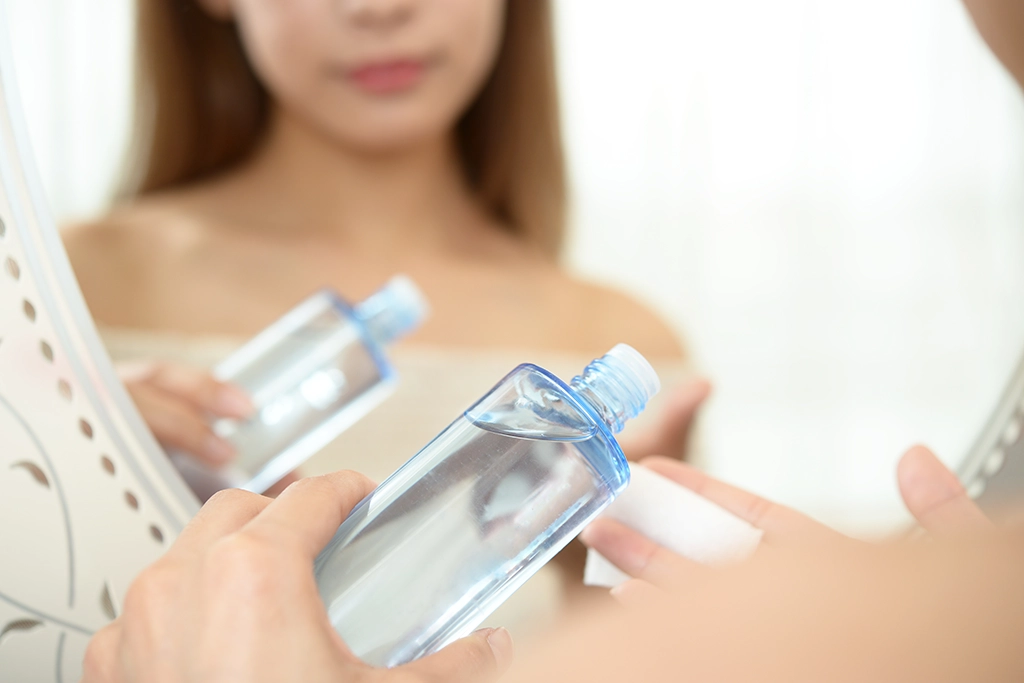Proper skin care is essential in order to maintain a beautiful and healthy appearance, and it is something anyone can master!
This guide is designed to interest both beginners and skin care professionals. It covers the basic steps of skin care, teaches how to properly select products, and answers frequently asked questions.
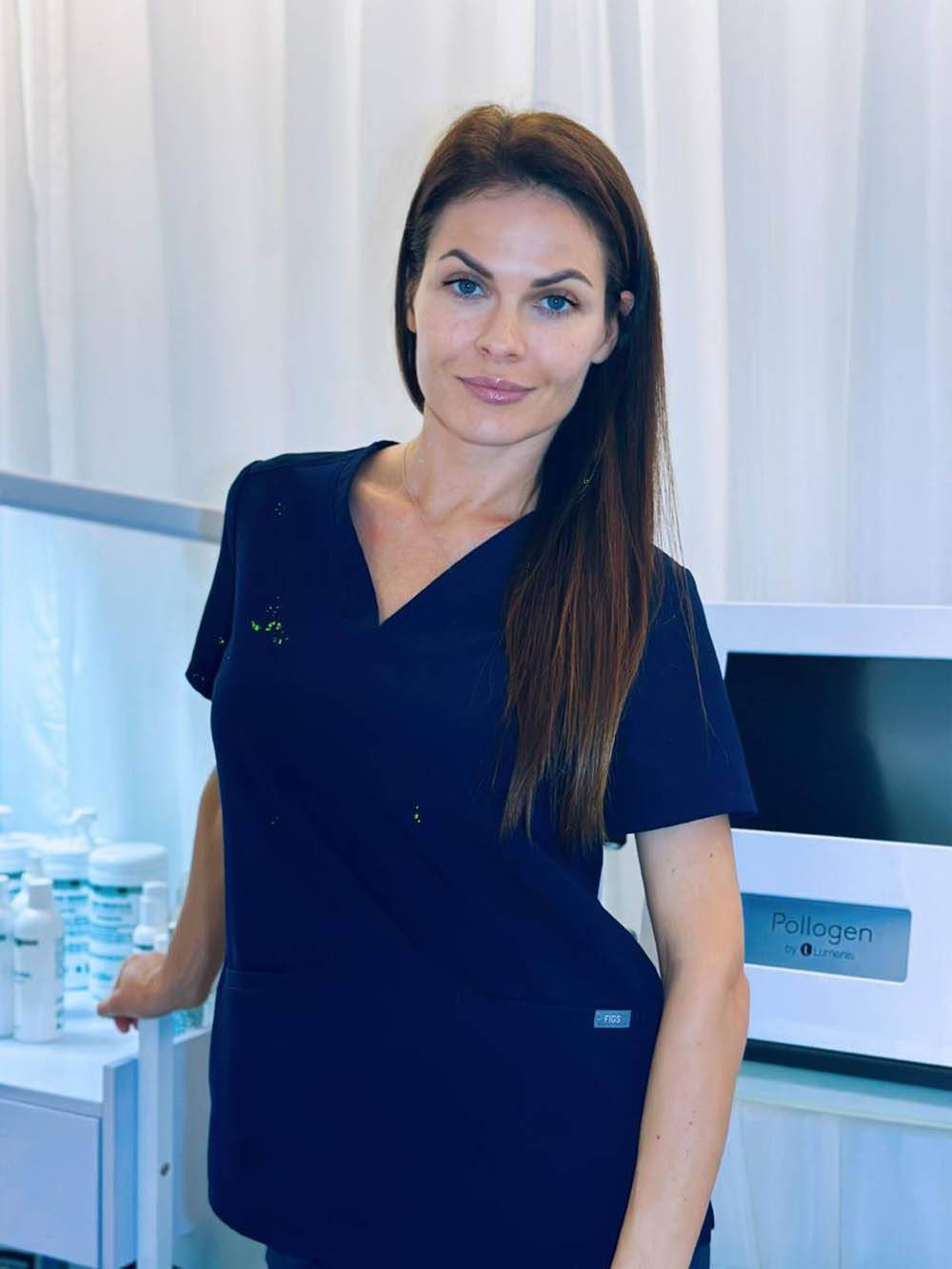
This guide is prepared by Yuliya Murillo, an instructor at the Prestige Health and Beauty Sciences Academy. With a medical background and over 10 years of experience in the beauty industry, Yuliya loves to educate others on skin care.
Her work encompasses various aspects of facial care, including hyperpigmentation, acne treatment, fractional mesotherapy, chromotherapy, and chemical peels. Her knowledge covers the most important aspects of skin care.
How do you start taking care of your skin?
At first glance, skincare might seem daunting, but it’s not as complicated as it appears! Anyone can start taking care of their skin.
How Can You Determine Your Skin Type?
To ensure effective skincare, it is crucial to identify your skin type. How can you do so?
Tissue Test
- Wash your face as normally would, using only a cleansing gel. After cleansing, your sebaceous glands will start to naturally produce sebum.
- After washing (30-40 minutes), firmly press a dry paper tissue against your face for 15 seconds.
- Assess the result based on the tissue's condition. If there are no oily marks, you have dry skin. If the sebum traces are faint, you have normal skin. If you notice oiliness in the forehead, nose, and chin area (T-zone), you have combination skin. If there's an even distribution of oiliness across all areas, you have oily skin.
Sensory Test
- Dry Skin: If you constantly feel tightness and experience flaking, and notice early fine lines due to lack of moisture, your skin type is likely dry.
- Oily Skin: If you often have an oily sheen across your entire face, breakouts, acne, and uneven texture, you likely have oily skin.
- Combination Skin: Typically, only the T-zone (forehead, nose, and chin) is prone to oiliness.
- Normal Skin: Usually characterized by healthy skin tone, velvety texture without breakouts, oiliness, or flaking.
Basic Skincare Steps for Beginners
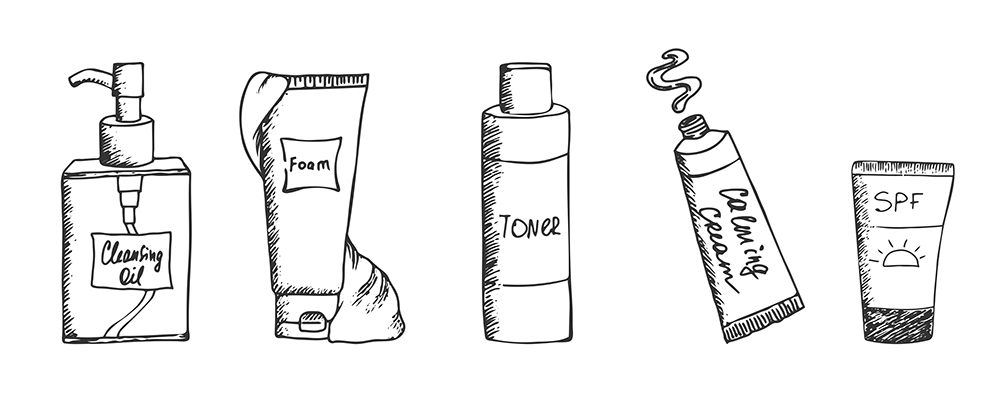
Starting a skincare routine can be a daunting task for beginners, given the plethora of products and procedures available. However, the rules of basic care are quite simple and involve just 4 key steps:
Cleansing
This helps remove impurities, excess oil, and dead skin cells that accumulate over the day. This fundamental step lays the groundwork for absorbing subsequent skincare products. Cleansing is essential both in the morning and at night, even if you don’t wear makeup. The effectiveness of subsequent steps depends on thorough cleansing.
Toning
The next step after cleansing. The components of the toner are aimed at restoring the skin's pH balance and enhancing its tone.
Moisturizing
A suitable moisturizer will nourish your skin and seal in the beneficial components of the toner. Moisturizing is necessary even for those with oily skin, as it helps reduce the appearance of wrinkles and evens out the skin tone, providing hydration by locking in moisture.
SPF Protection
Use a sunscreen with at least SPF 30 every day, even on cloudy days. This is crucial for protecting against environmental factors and preventing premature aging.
Additional Step – Targeted Treatments: Depending on specific skin issues, include serums or spot treatments in your routine. They can help address various concerns like acne, pigmentation spots, or fine lines.

Consistency and regularity are key to achieving results. Therefore, ensure that you can perform your skincare routine daily. Since everyone has different skin types, each care procedure is also unique. For example, if you have dry skin, you might skip the cleansing product in the morning or use a moisturizer more than once a day.
At our beauty school, you can take a specialized skin care course to gain the necessary knowledge and become a professional.
Mastering Skin Care Techniques
How Should You Properly Wash Your Face?
Cleansing should be done twice a day – in the morning and in the evening.
Morning Cleansing is essential because, during the night, our skin cells renew, and sebum and toxins accumulate on the surface. A gentle foam or gel is suitable for delicately removing these.
Evening Cleansing deals with the impurities that build up over the day and makeup residues. For your evening routine, first remove makeup residues with a hydrophilic oil or micellar water (even if you don’t wear makeup), and then wash your face with a foam or gel.
When washing, also pay attention to your neck. After washing, pat your skin dry with a paper towel, avoiding harsh rubbing to reduce microtrauma. Leave your face slightly damp – this helps in the absorption of active substances in your toner.
Do I Need a Toner?
Many skip toning, considering it an unnecessary step. In reality, using a toner is an important step. It restores the pH balance of the skin and prepares it for the absorption of active ingredients in your moisturizer. Apply the toner to a cotton pad and gently wipe the slightly damp face along the massage lines. If the toner is in spray form, then spray it onto your face and neck, followed by a light massage.
Exfoliation and Skin Renewal
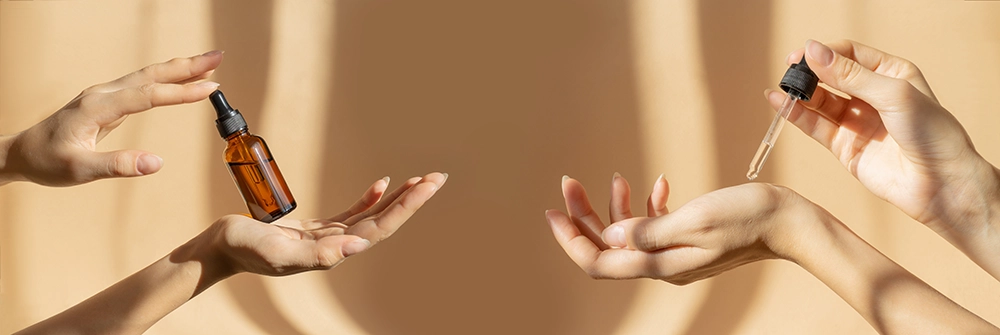
Exfoliation is a vital process for removing dead skin cells from the surface. It aids in regeneration, maintaining a radiant complexion, solving various skin issues, and enhancing the effectiveness of other skincare products.
1. Mechanical Exfoliation
This process involves physically removing dead cells using abrasive substances (salt, sugar, coffee, crushed fruit pits, enzymatic powder) or tools. This can be done no more than once every two weeks.
Methods:
Scrubbing
Apply a small amount of scrub to damp skin after cleansing, massage for a few minutes, then rinse with warm water.
Brushing (using a special device)
This should only be performed by a facial specialist! After cleansing, a warm compress is applied. Then, the esthetician chooses the appropriate attachment and gently treats the face, changing attachments as needed. A moisturizing cream is applied at the end of the procedure.
Benefits: Removes dead cells, improves skin texture, and stimulates cellular exchange.
Contraindications: Thin and sensitive skin, inflammations (pustules, acne), neoplasms (warts), allergic reactions, infectious diseases (herpes).
2. Chemical Exfoliation
Uses chemical compounds, like alpha-hydroxy acids (AHA) or beta-hydroxy acids (BHA), to dissolve dead skin cells.
Methods:
Superficial Peeling (penetrates the superficial layer of the skin)
Use serums with AHA and BHA acids. Cleanse your face thoroughly, remove moisture with a paper towel, apply the exfoliating mask with a cotton pad or brush, and leave it on for no more than 1 minute. Rinse off with water and apply a moisturizing cream with SPF.
Medium Peeling (penetrates the middle layer of the skin)
Use serums with salicylic, trichloroacetic, or glycolic acid. After cleansing, apply the serum with a fan brush. The composition is left on depending on the type of peeling, neutralized with an alkaline solution, then washed off with warm water. Finish with a moisturizing cream and SPF cream.
Deep Peeling (affects the basal layer of the skin)
Rarely used in cosmetology.
Benefits: Enhances skin radiance, evens out skin tone. Addresses hyperpigmentation, blackheads, acne, and post-acne issues.
Contraindications: Tanning, being under 18 years old, infectious diseases (herpes), neoplasms (warts, moles), taking ‘Roaccutane’, pregnancy, and lactation.
Benefits of Exfoliation:
- Improves collagen production, strengthening and increasing elasticity.
- Exfoliated skin better absorbs subsequent active substances. Serums and moisturizers penetrate deeper, maximizing their effectiveness.
How often should I exfoliate my skin?
Gentle exfoliating products are recommended to be used no more than 1-2 times a week. It’s also advised to avoid harsh scrubs with large abrasive particles, as they can damage the protective layer and potentially lead to infection. The most gentle options are gommages, peels, or serums containing acids.
How Can I Achieve Glass Skin?
Achieving “glass skin” is a popular Korean skincare trend known for exceptionally smooth, clear, and luminous skin that resembles glass. To achieve this effect, include the following steps and sequence in your routine:
1. Double Cleansing:
- Remove makeup and sunscreen residues with an oil-based cleanser (hydrophilic oil or balm).
- Follow with a water-based cleanser (gel or foam) for thorough cleaning.
2. Exfoliation:
- Regularly perform gentle exfoliation (1-3 times a week) to remove dead cells and stimulate cell turnover.
- Use both chemical peels (like AHA or BHA) and gentle physical exfoliants.
3. Moisturizing:
- Apply a hydrating toner to replenish moisture and prepare the skin for subsequent products.
- Use serums or essences containing hyaluronic acid.
- Apply a light but nourishing moisturizer to retain moisture.
4. Using Serums:
- Use brightening and hydrating serums with ingredients such as niacinamide, vitamin C, or alpha arbutin to combat hyperpigmentation and enhance radiance.
5. Sun Protection:
- Daily apply sunscreen with at least SPF 30, and SPF 50 during summer. This is crucial for preventing harmful skin conditions.
6. Sheet Masks:
- Use sheet masks 1-2 times a week with hydrating and brightening ingredients for an additional glowing effect.
7. Visit an Esthetician:
- For more intensive results, opt for professional treatments such as facials, chemical peels, or microdermabrasion.
8. Avoid Aggressive Components:
- They can cause irritation or allergic reactions. Test new products and introduce them gradually.
Remember, achieving “glass skin” is a gradual process. Choose products based on your skin type and its issues, consult with a dermatologist for personalized recommendations
Is it necessary to use facial masks?
Facial masks come in various types, each designed to address specific skin issues:
- Clay Masks: They absorb excess sebum, have a drying effect, and deeply cleanse the skin. Ideal for oily and acne-prone skin types, clay masks help to unclog pores and remove impurities.
- Gel Masks: These contain hydrating ingredients that combat dryness and flakiness. Gel masks are excellent for providing intense hydration and soothing the skin, making them suitable for dry and sensitive skin types.
- Masks with Alpha-Hydroxy Acids (AHA) or Enzymes: These offer gentle exfoliation. They help in removing dead skin cells, promoting cell turnover, and revealing a brighter and smoother skin surface. They are great for dull, uneven skin tones, and aging skin.
Additionally, using face masks can enhance the absorption of other skincare products and serve as a pleasant beauty ritual for relaxation. Regular use of the right type of mask can significantly improve the overall health and appearance of your skin.
Special Skin Care Needs
The specific needs in skincare depend on the skin type, its problems, and condition, requiring an individualized approach. Here are some common issues and their appropriate care:
Increased Sensitivity
Characteristic: May react aggressively to certain ingredients. Therefore, it's necessary to test the product on an inconspicuous area before applying it to the face.
Suitable Care: Choose hypoallergenic products without fragrances, with soothing ingredients like chamomile or aloe vera.
Acne-Prone Skin
Characteristic: Skin with numerous breakouts. It may be itchy, dry, and even painful.
Suitable Care: Choose non-comedogenic products to avoid clogging pores. For treating acne, look for products with salicylic acid or benzoyl peroxide. Use a gentle cleanser and a light, oil-free moisturizing cream.
Dry Skin
Characteristic: Hydration is a key step. Avoid harsh products.
Suitable Care: Opt for moisturizing products with ingredients like hyaluronic acid, glycerin, and oils. Use a gentle, hydrating cleanser.
Mature Skin
Characteristic: Requires hydration, collagen support, and antioxidants.
Suitable Care: Choose products with peptides, retinoids, and antioxidants. Use a rich moisturizing cream and sunscreen daily.
Hyperpigmentation
Characteristic: Presence of multiple pigment spots, uneven skin tone.
Suitable Care: Include vitamin C, niacinamide, and exfoliating agents like alpha-hydroxy acids (AHA) in serums.
Eczema-Prone Skin
Characteristic: Hydrating and soothing ingredients are very important.
Suitable Care: Use hypoallergenic, fragrance-free products containing ceramides. Regularly apply a rich moisturizing cream.
What is the best skin care routine for sensitive skin?
Sensitive skin requires gentle products that reduce irritation and inflammation. The basic care procedure includes:
Morning Routine:
Cleansing
- Use a gentle, fragrance-free cleansing foam.
- Pat the face dry with a soft towel.
Toning
- Choose a soothing, alcohol-free toner to balance the pH.
- Apply a small amount with gentle patting motions.
Serum
- Select a gentle, hydrating serum with hyaluronic acid or chamomile extract.
- Apply a small amount and allow it to absorb.
Moisturizing
- Choose a hypoallergenic, fragrance-free moisturizer.
- Apply evenly, especially on dry areas.
Sun Protection
- Use sunscreen with at least SPF 30.
- Reapply every two hours, especially when in the sun.
Evening Routine:
Gentle Makeup Removal
- Use a soft product or cleansing oil to remove makeup.
- Follow with your regular cleanser.
Cleansing
- Use the same gentle cleanser as in the morning.
Special Care
- For specific issues like redness, use a soothing product with aloe vera or calendula.
Night or Moisturizing Cream
- Choose a richer moisturizer for the night with ceramides or gentle plant extracts.
- Apply evenly, focusing on areas needing extra hydration.
Weekly:
Exfoliation (1-2 times a week)
- Use a gentle exfoliant with ingredients like lactic acid or oat extract.
- Apply with light massage movements, leave on for a while, then rinse off thoroughly.
Using a Sheet Mask (1-2 times a week)
- Choose a hydrating or soothing mask with chamomile or aloe vera.
Dealing with Acne-Prone Skin
Managing acne requires consistent and gentle care, lifestyle adjustments, and sometimes professional treatment.
Key Steps in Acne Management:
- Proper skincare,
- Choosing non-comedogenic products,
- Spot treatment with salicylic acid,
- Healthy eating,
- Maintaining personal hygiene,
- Consulting dermatologists, endocrinologists, or facial specialists.
What are the best natural ingredients for skin care?
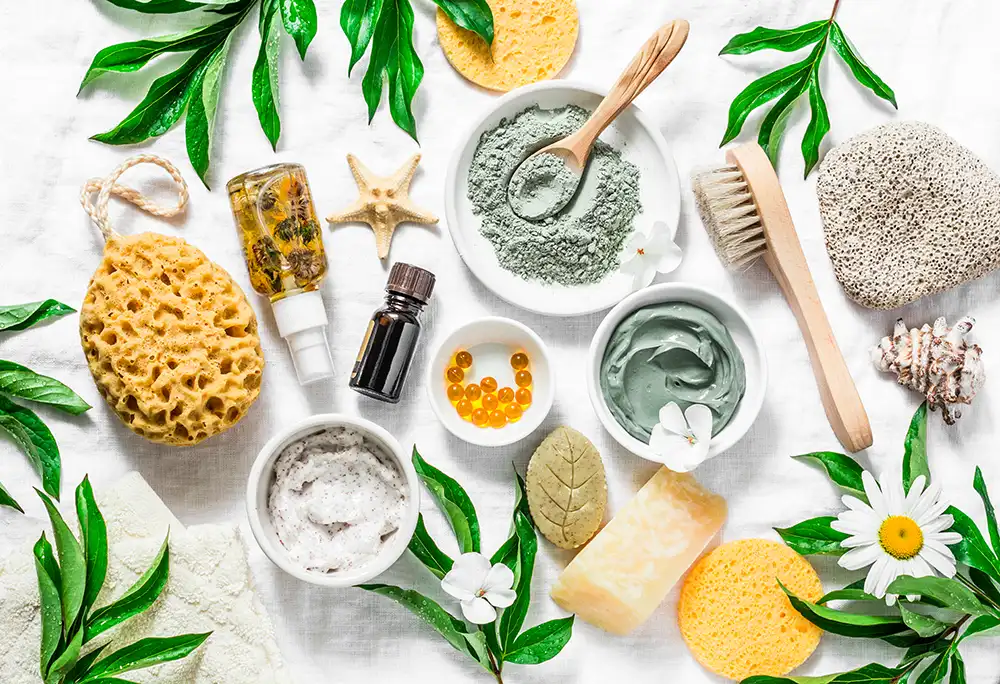
Natural ingredients are known for their beneficial properties in skincare. Here are some popular natural ingredients commonly found in various products:
- Aloe Vera: Known for its soothing and hydrating properties, it helps calm irritated skin and provide moisture.
- Honey: A natural humectant, it helps attract and retain moisture and has antibacterial properties.
- Coconut Oil: Rich in beneficial fatty acids, it moisturizes and protects against dryness.
- Tea Tree Oil: Known for its antimicrobial properties, making it effective for acne treatment. However, it should be used cautiously or properly diluted as it can cause allergies.
- Argan Oil: Rich in antioxidants and vitamin E.
- Green Tea Extract: Green tea is rich in antioxidants that protect against free radical damage. It also has anti-inflammatory properties.
- Chamomile Extract: Has anti-inflammatory and soothing properties.
Remember, it’s important to use natural ingredients correctly and be aware of potential allergic reactions.
Identifying Harmful Ingredients in Skincare Products
Here are some guidelines to help detect harmful ingredients in your cosmetics:
- Learn to Read Labels: Familiarize yourself with ingredient names and their effects.
- Avoid Common Irritants: Such as fragrances, artificial dyes, and preservatives.
- Check for Harsh Cleansing Agents: Like Sodium Lauryl Sulfate (SLS) or Sodium Laureth Sulfate (SLES), which can cause dryness or irritation.
- Be Wary of High Alcohol Content: High concentrations can be irritating.
- Avoid Mineral Oil or Petroleum Jelly: They can clog pores.
- Check for Harmful Preservatives: Such as DMDM Hydantoin, Imidazolidinyl Urea, which can cause irritation.
- Use Online Resources: Websites and apps that provide information about hazardous ingredients can be very helpful.
Always remember, what works for one person may not work for another, so it’s essential to understand your skin type and any sensitivities you may have.
Can You Make Money By Being A Skincare Specialist?
According to the U.S. Bureau of Labor Statistics, the profession of an esthetician in the United States is becoming increasingly essential, especially given the high demand for personal care services. The overall employment of beauty industry specialists is projected to grow by 8 percent from 2022 to 2032, faster than the average for all occupations. Annually, about 89,400 job openings for estheticians are expected over the decade.
At Prestige Health and Beauty Sciences Academy, we offer courses in skincare and self-makeup. After completing your training, you will receive a license and be able to apply these skills not only for personal use but also to become a professional in the beauty industry. This presents an excellent opportunity for those interested in pursuing a career in this field.
FAQ
1. Is Daily Skin Care Necessary?
Yes, daily skincare is essential for maintaining healthy and well-cared-for skin. A consistent routine helps address various skin concerns and protects it from external factors.
2. How Can I Effectively Remove Makeup?
The method of double cleansing has become popular recently. First, use a hydrophilic oil or balm, which are better at dissolving makeup residues and help gently remove makeup without harsh rubbing. Then, wash off the oil residues with a gel or foam cleanser.
3. How to Manage Oily Skin Throughout the Day?
Before leaving the house, use an oil-free moisturizer or a mattifying primer. Keep blotting papers handy; they quickly absorb excess sebum. Gently pat them on the T-zone or areas prone to oiliness.
